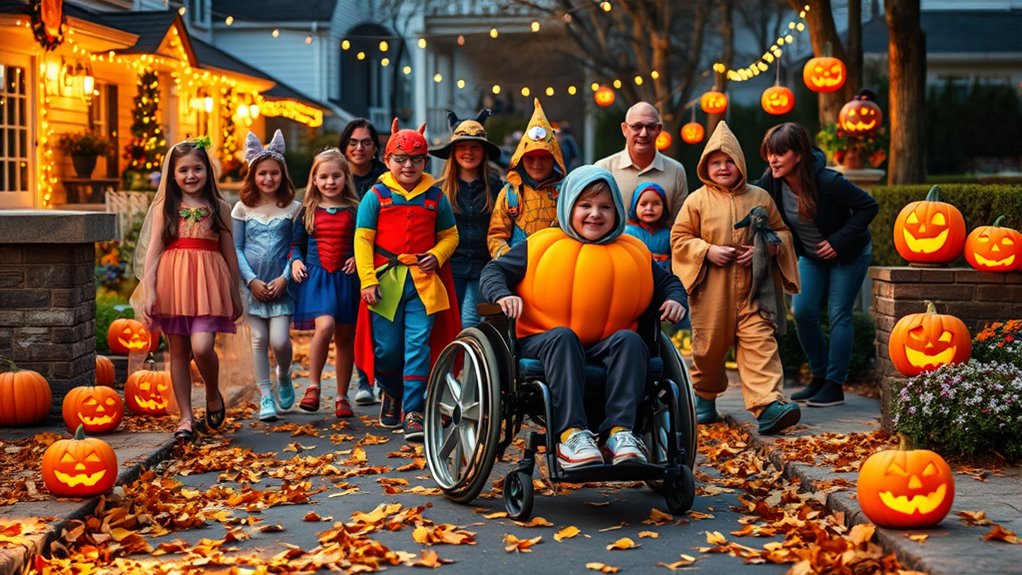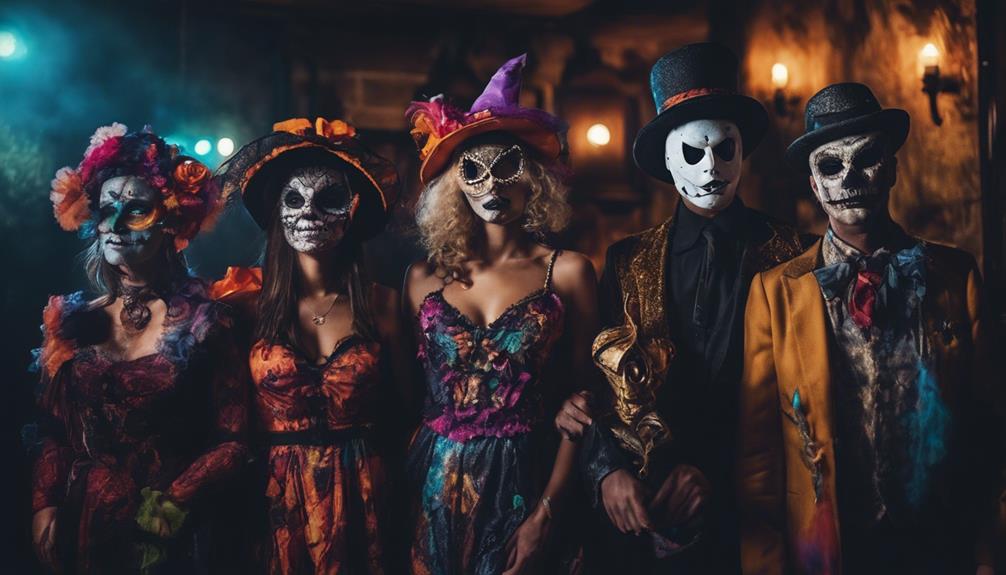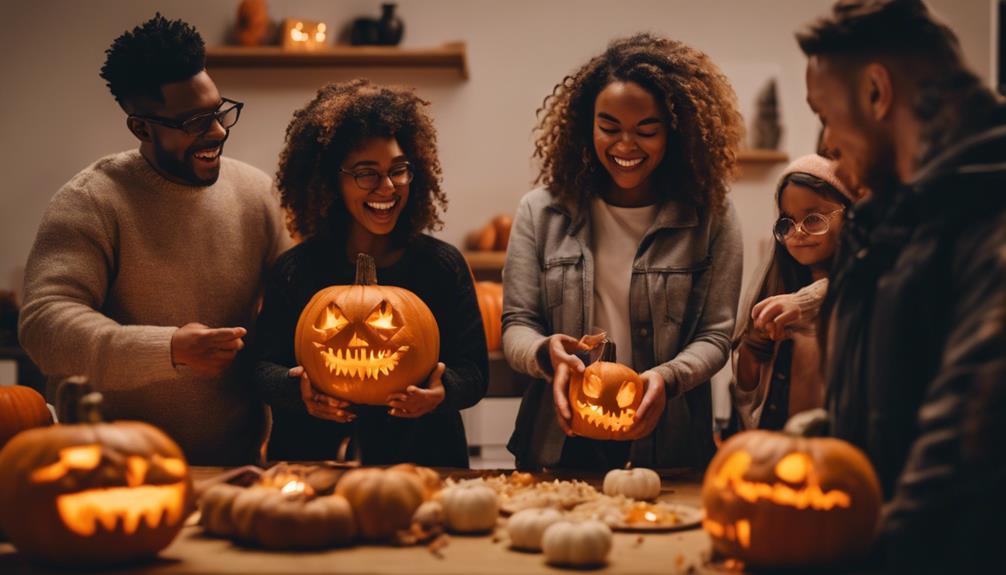To make Halloween celebrations accessible, focus on inclusive costumes, sensory-friendly activities, and low-stimulation trick-or-treat options. Create calm zones and use clear signage to help kids with sensory sensitivities navigate comfortably. Organize community events that consider different needs, like quiet spaces or contactless treats. Pay attention to decorations and environments that promote safety and comfort for all children. Keep exploring to discover more tips for ensuring everyone can enjoy Halloween to the fullest.
Key Takeaways
- Offer sensory-friendly costumes with soft fabrics, simple designs, and comfortable fits to accommodate sensory sensitivities.
- Create low-stimulation trick-or-treat zones and organize quiet spaces for children needing a break.
- Use inclusive decorations like visual cues and large print signs to make events accessible for all children.
- Incorporate sensory-friendly activities and minimize loud noises or flashing lights at Halloween celebrations.
- Foster a welcoming community atmosphere that encourages participation and awareness of diverse needs during festivities.

Halloween is a time for everyone to celebrate and enjoy without feeling left out. You want all kids to experience the fun, whether they love dressing up or prefer a quieter way to participate. That’s where inclusive Halloween ideas come into play. By offering sensory friendly costumes, you help children who might find traditional costumes overwhelming. These costumes are designed with soft fabrics, simple designs, and tags or embellishments that won’t irritate sensitive skin. They might feature muted colors or comfortable fits, making them a perfect choice for kids with sensory processing differences. When you choose or create sensory friendly costumes, you’re making sure that every child can enjoy dressing up without feeling uncomfortable or overwhelmed.
Adaptive trick or treating is another key way to make Halloween accessible. If you’re hosting or participating in community trick-or-treating, consider ways to adapt the experience for children with mobility challenges or sensory sensitivities. You could set up a designated, low-stimulation area where kids can collect candy at their own pace, or organize a neighborhood event with clear pathways, good lighting, and quiet zones. Some families might prefer alternative methods of receiving treats, such as drive-by trick or treating or handing out goodies in a contactless manner. These adaptations ensure that children who might find traditional door-to-door canvassing stressful or inaccessible still get to enjoy the thrill of collecting treats. It’s all about creating an environment where everyone feels safe, comfortable, and included.
You can also encourage local communities or neighbors to get involved by sharing ideas for inclusive decorations and activities. For example, visual cues, large print signs, or sensory-friendly activities like calm coloring stations can help children with different needs participate happily. When you’re planning Halloween events, consider the sensory environment—minimize loud noises, flashing lights, and crowded spaces to accommodate children with sensory sensitivities. Incorporating accessible venues can further ensure that events are welcoming for all children. Remember, inclusion isn’t just about costumes and treats; it’s about creating a welcoming atmosphere where kids of all abilities feel they belong.
Frequently Asked Questions
How Can I Create Sensory-Friendly Halloween Activities?
You can create sensory-friendly Halloween activities by incorporating visual cues, like clear signs and simple decorations, to help everyone understand what’s happening. Use calming techniques such as soft lighting and quiet spaces for those who need a break. Offer alternative activities for kids with sensory sensitivities, and keep sounds and textures gentle. This way, you guarantee all guests feel comfortable and included during the celebration.
What Are Effective Ways to Include Non-Verbal Participants?
Did you know that nearly 1 in 7 people worldwide has some form of communication disability? To include non-verbal participants, you should incorporate sign language and visual communication tools like picture boards or visual schedules. These methods make it easier for non-verbal individuals to participate fully, ensuring everyone feels included and engaged in Halloween celebrations. Using sign language and visual tools creates a welcoming environment for all attendees.
How Do I Adapt Costumes for Accessibility?
To adapt costumes for accessibility, start with adaptive clothing that’s easy to put on and take off. Use visual cues like bright colors or textures to help individuals identify costume parts. You can also include sensory-friendly materials to guarantee comfort. Always consider the person’s specific needs and preferences, and involve them in the process. This way, you create inclusive costumes that are both fun and accessible for everyone.
What Community Resources Support Inclusive Halloween Events?
Community connections can create compelling, inclusive Halloween experiences. You can call on local organizations, community centers, and nonprofits to collaborate on celebrations. These community partnerships foster fun and guarantee accessibility for all. Volunteer coordination plays an essential role, helping to staff special events and provide support where needed. Reach out to these resources, and you’ll build a better, more inclusive bash, making sure everyone feels welcome and involved in the festivities.
How Can I Educate Others About Accessibility Needs?
To educate others about accessibility needs, you can start by sharing information through awareness campaigns that highlight the importance of inclusivity. Use inclusive language to guarantee your message is respectful and clear. Encourage open conversations and provide resources or examples of accessible practices. By promoting understanding and empathy, you help others recognize diverse needs, fostering a more inclusive environment at events like Halloween celebrations.
Conclusion
As you craft an inclusive Halloween, remember it’s like tending a vibrant garden—each unique flower adds to its beauty. When you nurture understanding and accessibility, you create a landscape where everyone can bloom and thrive. Your efforts become the gentle rain that nourishes diverse spirits, allowing community bonds to grow stronger. Embrace the role of the gardener, knowing that in fostering inclusion, you cultivate a celebration where all can feel seen, valued, and truly part of the harvest.









